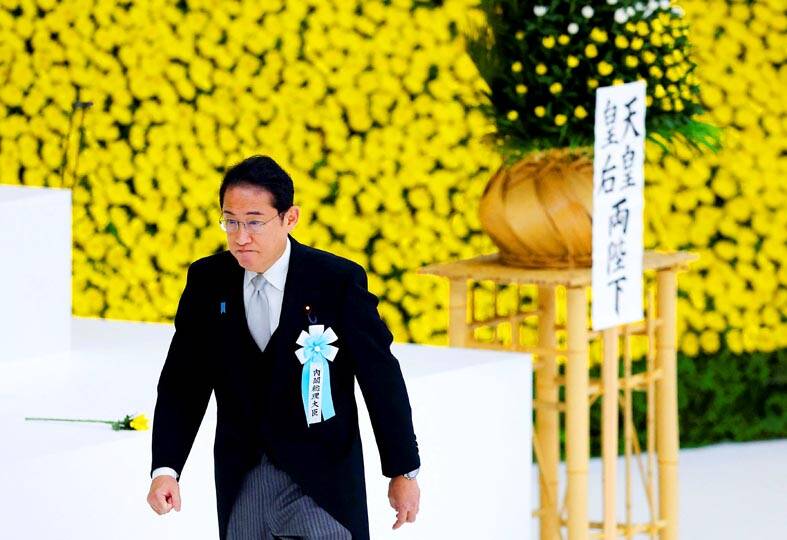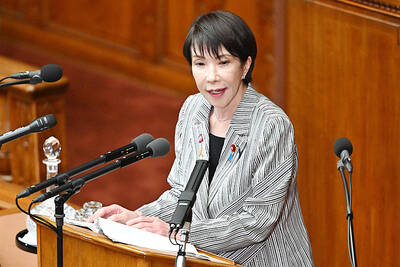The US, Japan and South Korea are to launch a series of joint initiatives on technology and defense when the nations’ leaders gather at Camp David on Friday, according to senior US administration officials, amid mounting shared concerns about China.
While the summit is unlikely to produce a formal security arrangement that commits the nations to each others’ defense, they would agree to mutual understanding about regional responsibilities and set up a three-way hotline to communicate in times of crisis, the officials said, speaking on condition of anonymity.
US President Joe Biden invited Japanese Prime Minister Fumio Kishida and South Korean President Yoon Suk-yeol to the storied presidential retreat in Maryland’s Catoctin Mountains as the Asian nations work to mend their tattered diplomatic relations in the face of greater regional threats posed by China’s rise and North Korea.

Photo: Reuters
It would mark the first in what US officials hope to be an annual gathering between the three nations’ leaders.
South Korea and Japan held their first joint summit in 12 years in March and have made steps to ease tensions after years of disputes, including some related to Japan’s 1910 to 1945 occupation of Korea.
Washington has formal collective defense arrangements in place with Tokyo and Seoul separately, but it wants the two nations to work closer together given growing concerns about China’s mounting power.
“We are anticipating some steps that will bring us closer together in the security realm,” said one of the US officials, adding that doing so would “add to our collective security.”
However, the official said that “it’s too much to ask — it’s a bridge too far — to fully expect a three-way security framework among each of us. However, we are taking steps whereby each of the countries understand responsibilities with respect to regional security, and we are advancing new areas of coordination and ballistic missile defense, again technology, that will be perceived as very substantial.”
The summit is also expected to lead to a joint statement between the nations that includes some language speaking to concerns about China’s desire to change the status of Taiwan.
The US, Japanese and South Korean joint statement is set to include language on maintaining peace and stability in the Taiwan Strait, one of the officials said.
The exact language on that and other provisions are expected to be negotiated up to the last minute, but the language currently under consideration would be consistent with prior US positions on the subject, avoiding a sharp escalation in rhetoric with Beijing as Washington has been seeking to ease tensions.

The Central Weather Administration (CWA) yesterday said it expected to issue a sea warning for Typhoon Fung-Wong tomorrow, which it said would possibly make landfall near central Taiwan. As of 2am yesterday, Fung-Wong was about 1,760km southeast of Oluanpi (鵝鑾鼻), Taiwan’s southernmost point, moving west-northwest at 26kph. It is forecast to reach Luzon in the northern Philippines by tomorrow, the CWA said. After entering the South China Sea, Typhoon Fung-Wong is likely to turn northward toward Taiwan, CWA forecaster Chang Chun-yao (張峻堯) said, adding that it would likely make landfall near central Taiwan. The CWA expects to issue a land

Taiwan’s exports soared to an all-time high of US$61.8 billion last month, surging 49.7 percent from a year earlier, as the global frenzy for artificial intelligence (AI) applications and new consumer electronics powered shipments of high-tech goods, the Ministry of Finance said yesterday. It was the first time exports had exceeded the US$60 billion mark, fueled by the global boom in AI development that has significantly boosted Taiwanese companies across the international supply chain, Department of Statistics Director-General Beatrice Tsai (蔡美娜) told a media briefing. “There is a consensus among major AI players that the upcycle is still in its early stage,”

The Central Weather Administration (CWA) yesterday said it is expected to issue a sea warning for Typhoon Fung-wong this afternoon and a land warning tomorrow. As of 1pm, the storm was about 1,070km southeast of Oluanpi (鵝鑾鼻), Taiwan’s southernmost point, and was moving west-northwest at 28 to 32kph, according to CWA data. The storm had a radius of 250km, with maximum sustained winds of 173kph and gusts reaching 209kph, the CWA added. The storm is forecast to pass near Luzon in the Philippines before entering the South China Sea and potentially turning northward toward Taiwan, the CWA said. CWA forecaster Chang Chun-yao (張峻堯) said

Japanese Prime Minister Sanae Takaichi yesterday said that China using armed force against Taiwan could constitute a "survival-threatening situation" for Japan, allowing the country to mobilize the Japanese armed forces under its security laws. Takaichi made the remarks during a parliamentary session while responding to a question about whether a "Taiwan contingency" involving a Chinese naval blockade would qualify as a "survival-threatening situation" for Japan, according to a report by Japan’s Asahi Shimbun. "If warships are used and other armed actions are involved, I believe this could constitute a survival-threatening situation," Takaichi was quoted as saying in the report. Under Japan’s security legislation,